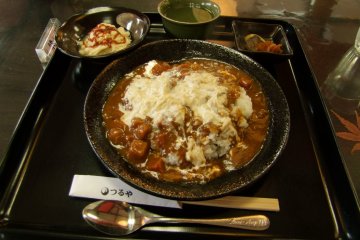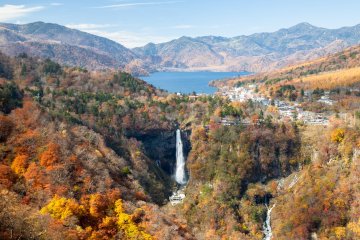
닛코의 지역 특산품, 유바
Todd Wojnowski유바는 도치기 현 닛코에서 유명한 맛있는 음식이다. 유바는 맛있고, 건강하며, 셀 수 없을 정도로 많은 방법으로 요리될 수 있다.

Among Nikko’s many world-renowned temples, stands the vibrantly colored Rinnoji (輪王寺), which was designated as a UNESCO World Heritage Site in 1999. Shodo Shonin, a Buddhist monk credited for introducing Buddhism to Nikko, founded the temple in the eight century. Lush forests and the mountainous landscapes of Mount Nantai, Nyoho, and Taro surround the collection of buildings, creating an atmosphere of sacred solitude. Many notable Buddhist figures were drawn to the temple’s pious isolation, including Kukai, the founder of the Shingon School of Buddhism, and Enjin, a priest of the Tendai School of Buddhism.
The Iemitsu Mausoleum (Taiyuin) may be closed to entry on the following dates: April 18th– 20th, May 17th, July 14th-15th.
Admission: 400 yen (Sanbutsudo only) / 900 yen (Sanbutsudo + Taiyuin) / 300 yen (Treasure House + Shoyo-en)
Rinnoji is located about half way between Nikko's Shinkyo Bridge and Toshogu Shrine. It's a 10 min bus ride or 30-40 min walk from Nikko Station (buses are included in the Nikko Pass).

유바는 도치기 현 닛코에서 유명한 맛있는 음식이다. 유바는 맛있고, 건강하며, 셀 수 없을 정도로 많은 방법으로 요리될 수 있다.

닛코 근처의 츄젠지 호수 근처에 있는 쓰루야 레스토랑은 그 지역의 유명한 음식인 유바를 포함한 다양한 음식을 제공합니다.

The Nikko Toshogu Shrine is arguably one of the most important religious sites in Japan and is located in the forests of Tochigi Prefecture. The shrine is the final resting place of Tokugawa Ieyasu, the samurai leader who united Japan in the early 1600s and the first ruler of the Tokugawa shogunate of the same name, which ruled Japan for over 250 years until 1868. Originally a relatively simple mausoleum, Toshogu was expanded in the first half of the 16th century by Ieyasu's grandson Iemitsu to create the spectacular complex that can be visited today. The shrine complex consists of more than a dozen buildings, which have been refined with countless wood carvings and large amounts of gold leaf. This is very unusual as there is usually an emphasis on simplicity in shrine architecture. Toshogu contains both Shinto and Buddhist elements. The wood carving of the monkeys who see no evil, speak no evil, and hear no evil is best known.

Tamozawa Imperial Villa is a former imperial summer residence in Nikkō, Tochigi Prefecture, Japan. It was constructed for Emperor Taishō in 1899 and served as a hide-out for emperor Hirohito during World War II. The former imperial residence is now open for the public as museum and garden. [Wikipedia]

The Kegon Falls are located on Lake Chuzenji in Nikko National Park in Tochigi Prefecture. The 97-meter-high falls are one of Japan's top three waterfalls and are also considered one of the top eight viewpoints in Japan from the Showa period. Overall, they exist 12 waterfalls, all located under or parallel to a large waterfall, the other two famous waterfalls are Nachi Waterfall in Wakayama Prefecture and Fukuroda Waterfall in Ibaraki Prefecture. They are especially popular during the fall foliage season when visitors travel to Nikko to admire the golden-orange colors. You can use an elevator there to see everything up close. In winter, the waterfalls even freeze over completely.